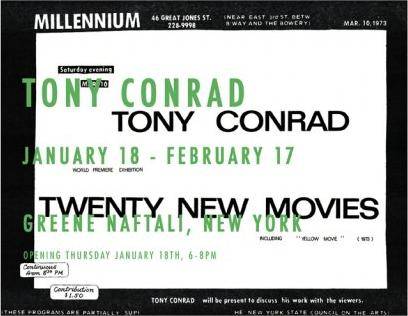Tony Conrad
18 Jan - 17 Feb 2007
TONY CONRAD
Greene Naftali is pleased to present an exhibition of “Yellow Movies” by Tony Conrad, a legendary New York underground filmmaker, composer, and artist. This exhibition marks Conrad’s first solo show at the gallery and is a re-presentation of the original one-night “screening” of this same body of work at Millennium in 1973.
Using house paint applied to large irregular sheets of seamless paper in the shape of movie screens, Conrad’s “Yellow Movies” are the slow process of the paint yellowing over years and decades—films which can outlast a viewer’s lifetime. Perceived as a cultural intervention, this work was an attempt to disrupt the progression of experimental cinema by taking the definition of "film" to an absurd extreme and wrenching it away from its technological necessities. Now, presenting these seminal works 30 years later, the issues they raise are even more expansive, occupying an unusual territory in between painting, film, and installation.
In seeking to dismantle the authoritarian boundaries of film culture during 1972-74 I turned to extended duration as a conceptual armature. The Yellow Movies were a solution to the problem of how to produce films that could run for a lifetime. Only by assaulting and occupying the arena of industrial film-material manufacturing (occupied by Kodak, Fuji, Orwo, etc.) could a movie experience be generated that would change almost imperceptibly slowly—“a movie" that would be very slightly, yet measurably sensitive to light. The emulsion that served this purpose was cheap house paint—or, in the case of the video version, day-glo silkscreen ink.
—Tony Conrad, 2005
Tony Conrad has always been at the forefront of avant-garde practice. Beginning with his anti-art demonstrations in the early 60’s with Henry Flynt and Jack Smith, his work has consistently expressed a heightened awareness of the power structures inherent in all artistic encounters. His collaborations with La Monte Young and others created what was later termed "minimalism" in music, radically dismantling the long-standing relationship between "composer", "performer", and "audience." In 1966, Conrad produced "The Flicker," a seminal film made entirely of alternating black and white film frames, which helped to usher in a new era of formal exploration in cinema. Conrad has continued his highly experimental practice, moving freely between all conceivable artistic mediums (music, film, video and television, performance, painting, sculpture). More recent collaborators include Mike Kelley, Tony Oursler, and Jim O’Rourke among others.
Tony Conrad's work is on-view at ZKM in Germany as part of the exhibition "Mind Frames: Media Study at Buffalo 1973-1990." His work was also included in the most recent Whitney Biennial. The book Beyond the Dream Syndicate: Tony Conrad and the Arts after Cage, by Branden W. Joseph is forthcoming from Zone Books in 2008. For further information and images please contact the gallery or visit our website at www.greenenaftaligallery.com
Greene Naftali is pleased to present an exhibition of “Yellow Movies” by Tony Conrad, a legendary New York underground filmmaker, composer, and artist. This exhibition marks Conrad’s first solo show at the gallery and is a re-presentation of the original one-night “screening” of this same body of work at Millennium in 1973.
Using house paint applied to large irregular sheets of seamless paper in the shape of movie screens, Conrad’s “Yellow Movies” are the slow process of the paint yellowing over years and decades—films which can outlast a viewer’s lifetime. Perceived as a cultural intervention, this work was an attempt to disrupt the progression of experimental cinema by taking the definition of "film" to an absurd extreme and wrenching it away from its technological necessities. Now, presenting these seminal works 30 years later, the issues they raise are even more expansive, occupying an unusual territory in between painting, film, and installation.
In seeking to dismantle the authoritarian boundaries of film culture during 1972-74 I turned to extended duration as a conceptual armature. The Yellow Movies were a solution to the problem of how to produce films that could run for a lifetime. Only by assaulting and occupying the arena of industrial film-material manufacturing (occupied by Kodak, Fuji, Orwo, etc.) could a movie experience be generated that would change almost imperceptibly slowly—“a movie" that would be very slightly, yet measurably sensitive to light. The emulsion that served this purpose was cheap house paint—or, in the case of the video version, day-glo silkscreen ink.
—Tony Conrad, 2005
Tony Conrad has always been at the forefront of avant-garde practice. Beginning with his anti-art demonstrations in the early 60’s with Henry Flynt and Jack Smith, his work has consistently expressed a heightened awareness of the power structures inherent in all artistic encounters. His collaborations with La Monte Young and others created what was later termed "minimalism" in music, radically dismantling the long-standing relationship between "composer", "performer", and "audience." In 1966, Conrad produced "The Flicker," a seminal film made entirely of alternating black and white film frames, which helped to usher in a new era of formal exploration in cinema. Conrad has continued his highly experimental practice, moving freely between all conceivable artistic mediums (music, film, video and television, performance, painting, sculpture). More recent collaborators include Mike Kelley, Tony Oursler, and Jim O’Rourke among others.
Tony Conrad's work is on-view at ZKM in Germany as part of the exhibition "Mind Frames: Media Study at Buffalo 1973-1990." His work was also included in the most recent Whitney Biennial. The book Beyond the Dream Syndicate: Tony Conrad and the Arts after Cage, by Branden W. Joseph is forthcoming from Zone Books in 2008. For further information and images please contact the gallery or visit our website at www.greenenaftaligallery.com

